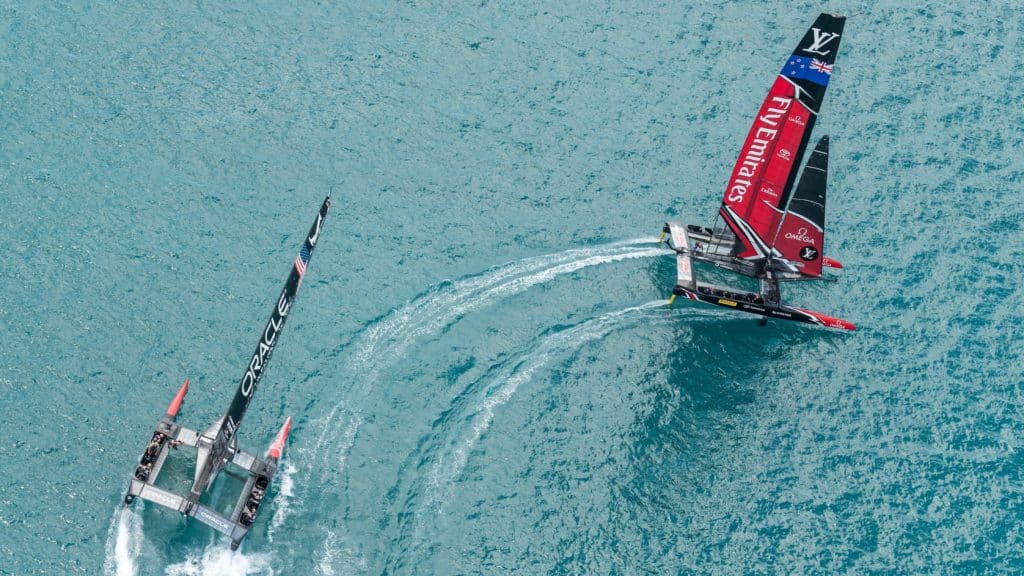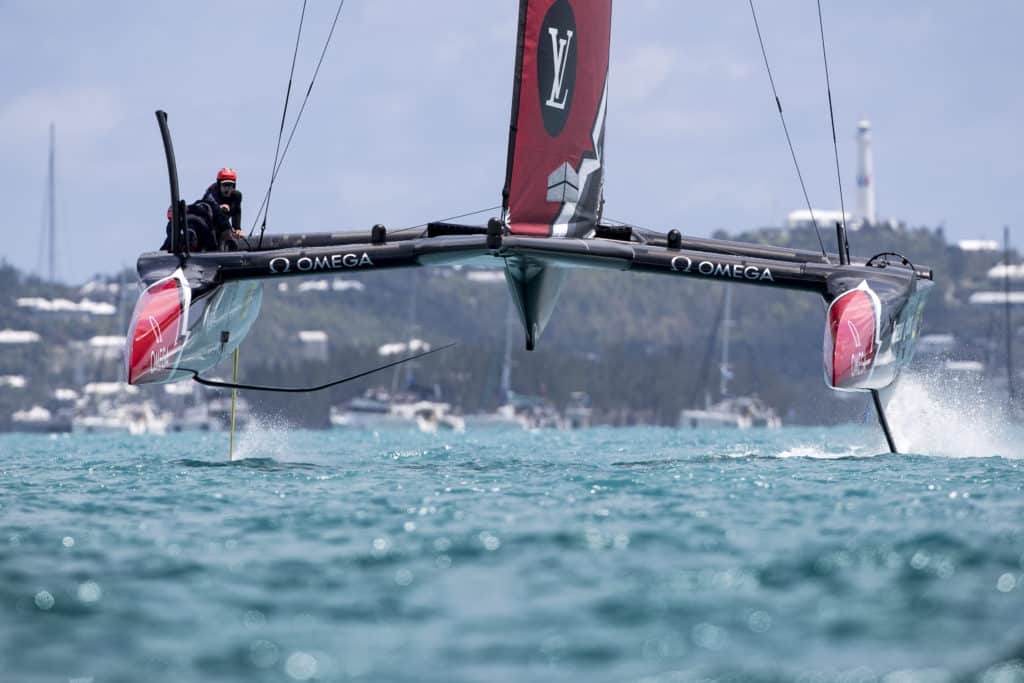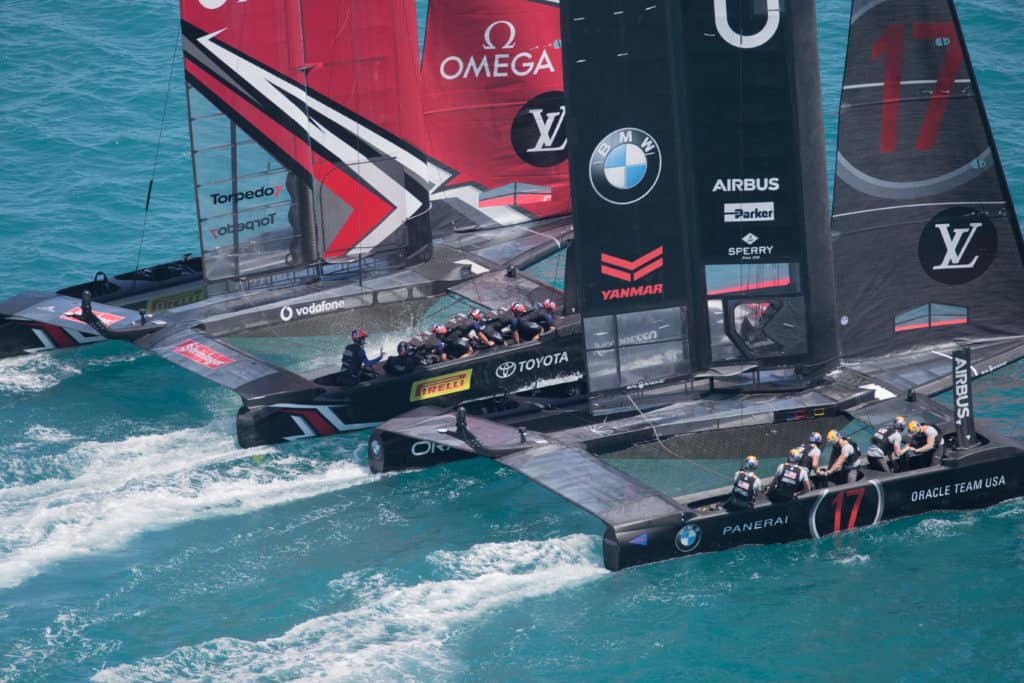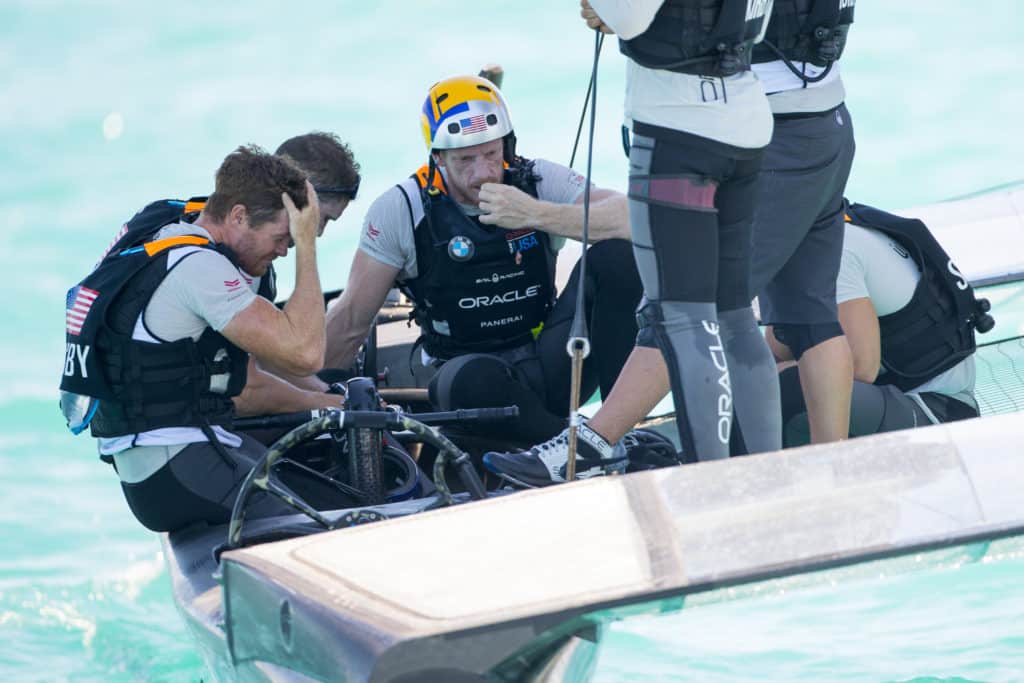
The New Zealand entourage rolled into Bermuda casually late for the America’s Cup party, erected a stark, white-tented compound behind the row of food vendors in the Village, and got right to business. They didn’t waste a dime gussying up their base. If it weren’t for the big logo at the apex of their boat shed and the New Zealand flag streaming from the cable of a crane, you’d be hard-pressed to find them on the island.
Each morning throughout the Louis Vuitton America’s Cup Challenger Series and the 35th America’s Cup Match, however, you couldn’t miss them. While Oracle hid behind its fences, ETNZ’s engineers and shore crew would trickle out in plain sight to launch their sophisticated 50-foot catamaran. Like clockwork, the big red wing went skyward at 0900, the platform placed underneath and then hoisted into the water. Gawkers and journalists loitered behind metal barricades, hoping to get a hint of the innovative technology. Soon after, the sailors would pass by, dressed for the morning practice session, flashing wry smiles and quick nods of acknowledgement: no high-fives, no autographs and certainly no showboating.
They were visible now, but before arriving in Bermuda, the New Zealanders had trained alone, a hemisphere away, and no amount of spying prepared their rivals for the whipping they would receive at the hands of a 26-year-old helmsman savant, his wizard wing trimmer and four watt-cranking cyclers.
The uncompetitive French and British syndicates were dismissed in the opening rounds of the series. SoftBank Team Japan, quickest when strong winds ruffled Great Sound, was next, leaving Artemis Racing as the lone worthy rival to the New Zealanders. In what was the closest racing of the entire regatta, ETNZ emerged a faster, battle-hardened squad, plenty ready to take on its nemesis.
On the eve of the Match, Oracle Team USA’s top brass were confident in their platform but anticipated a stiff challenge. “We felt it was going to be a dogfight,” says Scott Ferguson, Oracle Team USA’s technical director, the man in charge of all things design. “All of us, internally, thought we would have similar speed, and that it would come down to maneuvers and starts.”
That, we now know, was wishful thinking. Team New Zealand dominated both of the opening races from start to finish. Skipper Jimmy Spithill and company were rusty, and it showed. Downwind, the New Zealanders sailed lower and faster — a good 2 knots faster at times — and on the upwind legs, boatspeed differences occasionally hit double digits.
“Our daggerboard tips were angled down more than any of the other teams,” says ETNZ coach Ray Davies, “which made them faster upwind but harder to sail, but our control systems were better and we were able to achieve the same stability with the faster foil, and that’s where we were faster upwind. We were able to sail higher, with more windward heel, which gave us more grip on the leeward daggerboard.”
Spithill stated there was nothing to speculate about boatspeed differences between the two, on account of the day’s light and patchy winds, but the fact remained helmsman Peter Burling and company were one up on the scoreboard, having wiped away the bonus point the defender carried in from the challenger series.
Oracle had no response to Emirates Team New Zealand’s offensive the following day either. Unable to hook Burling in the prestart, Spithill let him get away. At times, Team New Zealand was a good 5 knots faster as the cyclers’ heart rates beat along with their cadence. As the handles spun on Oracle, you could hear Spithill’s desperation amid the calls to “dig in” for more oil.

Did the bikes make a difference? Definitely, says Ferguson. “We considered them early on, but there was concern about the aero penalty, and the guys getting off the bikes and across.” Many of the decisions are collective, he adds, but this was one owned by the sailors.
In the second race of the day, in 10 knots of wind, Oracle tried for the pre-start hook but didn’t get it. Instead, they got slow and the Kiwis got faster, “a lot faster,” Oracle tactician Tom Slingsby noted to his helmsman. With a clear start again, the New Zealanders were off and running — by the time they flew through Gate 5, their lead was a half-mile of hurt.
The frustration was visible in Spithill’s face as he took to his hot seat at the press conference. His canned response was ready. “There is a lot of time to make changes,” he stated, noting the New Zealanders had stepped up their performance from the early rounds. “We clearly need to get more speed from our boat.”
The defender then had five days to mine its notebooks for solutions: foils, rudders, wings, control systems, techniques — they would look at everything. It was a difficult team meeting that Monday morning, says Ferguson. First to go were the horizontal rudder elevators that they’d dubbed “the seagulls.” They’d never used them in competition, and they were clearly not fast. Then came the weight-loss program.
“We were struggling to get to minimum weight, so we looked at every piece of the boat we couldn’t justify keeping,” says Ferguson. “We stripped everything we could get rid of.”
On the water, they experimented with daggerboard toe angle, which turned out be a wasteful trip down a rabbit hole. They reduced the area of their light-air daggerboards and switched to shorter rudders, which they knew would be OK in a straight line but likely to break the surface during maneuvers.
Meanwhile, the New Zealanders continued to clean up from their Louis Vuitton series capsize. They also refined a speed-producing alteration they “borrowed” from their rivals. “Shroud-gate,” as one New Zealand crewmember called it, was the one contentious rule interpretation of the Cup. Oracle had determined early on that loose lower shrouds allow the platform to wrack, which translates to more righting moment. To sail in this configuration, however, the lower portion of the wing had to be strengthened.
In the process of seeking measurement approval, Oracle ended up having to show its hand. The measurers said no, says Ferguson, but the defender lobbied the regatta director, who overturned the ruling. Once the Kiwis were in the loop, they took the tip and ran with it.
“The Oracle guys realized you didn’t need the lowers, and that allowed the whole platform to twist,” says Davies, “which, in effect, gives more offset in the rudders. It was a big advantage to be able to get the platform to wrack, and it wasn’t until the Cup that we had our whole package sorted. That was another gain, for sure, and we got to it just in time.”
After a five-day break in the action, Oracle returned for the second weekend of the series down four races and slightly more confident in their boat, but Emirates Team New Zealand was surgical in its win. Oracle shot itself in the foot several times, incurring an OCS penalty and crashing through three bad jibes, but the big one was a penalty during a crucial midrace dial-down.

For Kiwi fans, the move was a thing of beauty: Oracle lowered its board to set up for a tack from the left boundary, and in that moment, Burling had their number. Already on starboard, he bore away sharply to start the dial-down early and make it that much more difficult for Spithill to avoid when the two boats met. As Oracle turned up past the stern of the Kiwi boat, Slingsby broke the news to his helmsman.
“We’ve got a penalty?” Spithill responded incredulously. “I was altering the whole way!”
That’s not how the umpires saw it, and Spithill pleaded his case at the post-race press conference before taking a dig at the umpires for giving the New Zealanders “soft penalties.”
The Kiwis began the next day with another convincing win, and looked to continue their sweep in the second until Oracle took control of the race when the New Zealanders missed a windshift. Spithill was quick to seize upon the victory and throw a jab at the press conference.
“We’ve worked hard this week, and we saw these guys (nodding toward Peter Burling) take days off and made a commitment that we’d make the boat faster,” said Spithill. “We saw that today. We’re not sailing as well as we should be. Even in the second race, we had a pretty good lead and lost it again, but it’s good to be able to come back from a race like that. The point is, the boat is faster.”
As far as the New Zealanders were concerned, they gave that one away.
“We should have sailed the course instead of the competitor,” says Davies. “As soon as you get into shifty conditions and differences in pressure, it’s more important to race yourself around the course.” The win gave Oracle cause to celebrate, but they knew they were on borrowed time.
“The guys were really suffering that day,” says Ferguson. “We realized then that we could win races, but there were times where we were at critical pressures in the accumulators. If you’re not up to pressure going into a maneuver, you’ll lose it, and it will go bad.”
Pressure and control were never a concern for the Kiwis. Their sophisticated and manually driven daggerboard autopilot system, as well as Ashby’s dynamic wing controls, allowed them to effectively divide the labor on board. The competitive essence of their AC50 was “awesome,” says Davies.
“It’s how we envisioned the boat from the outset. We had the ability for Pete [Burling] to control most of the boat from the wheel, so we could sail the boat however we liked, from the no-look maneuvers in the light air to having the guys put their weight forward in the boat.
“Having the cyclers producing plenty of power and having the ability to control either foil from either side of the boat gave us a huge advantage for tactical options and the ability to easily pull off consistent maneuvers without much warning. The boats are thirsty for hydraulic oil, and to have the bikes cranking out huge wattage for the whole package certainly helped.”

Cyclers Blair Tuke and Andy Maloney flew the boat with controls at their handlebars, leaving Burling free to focus on the race. Controls on Burling’s steering wheels enabled him to fly the boat if needed, and control the wing trim as well. When wing trimmer Glen Ashby went to leeward, for example, Burling could trim the wing, and conversely, when Ashby arrived at the other wheel out of a maneuver, he could trim the wing as Burling crossed.
“We contemplated whether we even needed a wing trimmer in certain conditions,” says Davies. “We had an option to put another bike on the boat, but we didn’t need to. To control the wing from the wheel opened up a lot of consistency in our maneuvers.”
Much ado was made before the Match about Burling’s match-racing experience in the pre-start box, but with every start he managed fine by never engaging with Spithill and using his maneuverability to stay out of harm’s way. On the penultimate day, however, he finally showed Spithill who was boss. In the most telling moment of the match, Burling foiled into a leeward hook in the start of the day’s second race, and as he glided to leeward, spitting distance from Oracle’s port hull, he took his right hand off the steering wheel, glanced over at his rival and gave a mocking wave. Maybe he was signaling Spithill to turn up, but that’s not how it appeared. It was more like, “Hello, Jimmy … and goodbye.” Off sped the New Zealanders to another trouncing, bringing the series to 6-to-1 and match point.
Less than 24 hours later, cyclers Simon Van Velthooven, Andy Maloney and Josh Junior, flight controller Blair Tuke, trimmer Glen Ashby, and Peter Burling would deliver the decisive blow to Oracle Team USA in a move they’d practiced many times but never had the chance to deliver in a race.
The opportunity presented itself early in Leg 2 of Race 9 as Oracle led the New Zealanders toward the first boundary after Mark 1 with a 10-meter lead. The playbook says he who jibes first gets the jump, and racing sailors know the move well as the “no-look jibe.”
“Basically we have the ability to fire the windward board and jibe without sending anyone to leeward, so they didn’t know we were jibing,” said Tuke afterward.
They trained for this exact scenario knowing that the team that follows through Mark 1 has to beat the boat ahead to the jibe. As was the case throughout this lopsided series, Oracle didn’t see it coming, was late to react, and slow out of its jibe. As soon as both boats were up and foiling again, the writing was on the wall. “It’s something we trained a lot on, and when you pull it off in racing, it is a nice feeling,” added Tuke. “To do it in the last race was pretty cool.” Behind the sailors of Emirates Team New Zealand is team of teams, one that crafted the most technical boat the America’s Cup had ever seen. As with all other challengers left in Emirates Team Zealand’s wake, the 35th defender never stood a chance. They had the wrong tool for the job.
From the isolation of the proud Kiwi Nation came a squad that was determined, one that dared to be to different, and the tool they brought to Bermuda was a masterpiece of innovation: from the appendages, the hydraulic controls, the dynamic wing, the intelligent software and, yes, the game-changing cyclers, which allowed them precision trim and on-demand oil. All of this, handled by a young sailing team flush with experience winning at the highest levels, was the complete package. The fastest boat won, there’s no doubt about it, conceded Spithill, the raw emotions of the defeat noticeable in his voice. “They fully deserved it. They had all the speed.”









